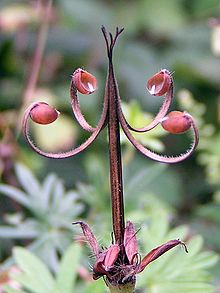Blood-red cranesbill
| Blood-red cranesbill | ||||||||||||
|---|---|---|---|---|---|---|---|---|---|---|---|---|

Blood-red cranesbill ( Geranium sanguineum ) |
||||||||||||
| Systematics | ||||||||||||
|
||||||||||||
| Scientific name | ||||||||||||
| Geranium sanguineum | ||||||||||||
| L. |
The blood red cranesbill or blood cranesbill ( Geranium sanguineum ), also blood florets and chickens root called, is a plant from the genus of geranium ( Geranium ) within the family of geraniaceae (Geraniaceae). It is also native to Central Europe.
description
Vegetative characteristics
The blood-red cranesbill is a perennial herbaceous plant and reaches heights of 15 to 50 (rarely 60) cm. It forms a far crawling, wherein a diameter of about 1 cm relatively thick rhizome , which branches with low leaves is busy and red inside. The stems are prostrate to ascending and mostly forked from the base. The light green, blood-red stems in autumn are densely covered with hairs 1 to 2.5 mm long, horizontally or backwards, or almost bald. Glandular hairs are rare.
The basal leaves dry up early. The basal leaves are opposite, the lowest are 4 to 9 cm long, the upper stalked 0.5 to 3 cm long. The blade is divided into seven (rarely five or six) sections and 3 to 5 (rarely 8) cm wide. They are mostly hairy on both sides. The sections have one to three linear, pointed tips. The red-brown, dry-skinned stipules are ovate to lanceolate with a length of 0.5 to 1.5 cm and scattered to shaggy on the edge.
Generative characteristics
The partial inflorescences are single-flowered (rarely two-flowered) and are 2 to 7 (rarely 1 to 10) cm long stalked, while projecting over the bracts. The flower stalks are 1 to 3 cm long, nod after pollination and stand upright again when the fruit is ripe. Both stalks are hairy with long white protruding hairs and also have sessile glands.
The hermaphroditic flowers are radial symmetry and five-fold with a double flower envelope . The five free sepals are 8 to 13 mm long, 1 to 2.5 mm pointed and have three to seven nerves, and are particularly hairy on these. The corolla has a diameter of 2.5 to 4 cm. The five free, bright red-violet petals measure 13 to 18 (rarely 20) mm in length, are long, inverted-heart-shaped and sometimes have irregular margins. Your nail is hairy short. There are two circles with five stamens each, which are shorter than the sepals. The stamens are widened at the base, their edge is ciliate.
The fruit is 3 to 4 cm long. The beak and the fruit valves are hairy and glandless. The seeds are smooth to very finely dotted.
The species has chromosome number 2n = 84.
ecology
The flowers are proterandric . They are nectar-bearing disc flowers . The scars are receptive a day or two before the anthers . In addition to insect pollination, self-pollination also occurs. The most common flower visitors are hoverflies , hymenoptera , but also butterflies and beetles . Flowering time is May to September.
As with all geraniums, the fruit acts as a dehydrator .
Occurrence
The blood-red cranesbill is native to sub-ocean Europe. Its area is meridional / montane to temperate. It grows on dry, bushy slopes, in steppe heaths and sparse forests. It is a character species of the Geranion sanguinei association, but also occurs in associations of the Quercion pubescentis, Berberidion, Cytiso-Pinion or Erico-Pinion associations. It thrives mainly on dry, loose, nutrient-poor and often lime-rich soils . It can be found from the collinen to the montane (rarely subalpine) altitude , in Tyrol it rises occasionally to altitudes of up to 1500 meters. In the Allgäu Alps, it rises in the Tyrolean part in the rear Hornbachtal on the Mutte up to 1550 m above sea level.
It is rare in northern Germany and scattered in the south. The blood-red cranesbill was the flower of the year in Germany in 2001 and is, for example, classified as a highly endangered plant species on the Red List in Saxony .
In Austria the species occurs frequently in the Pannonian area and partly in Carinthia , otherwise only scattered or rarely. The blood cranesbill is missing in Salzburg .
literature
- Rudolf Schubert , Klaus Werner, Hermann Meusel (eds.): Excursion flora for the areas of the GDR and the FRG . Founded by Werner Rothmaler. 13th edition. tape 2 : vascular plants . People and knowledge, Berlin 1987, ISBN 3-06-012539-2 (area).
- Siegmund Seybold (Ed.): Schmeil-Fitschen interactive . CD-ROM, version 1.1. Quelle & Meyer, Wiebelsheim 2002, ISBN 3-494-01327-6 .
- Manfred A. Fischer, Karl Oswald, Wolfgang Adler: Excursion flora for Austria, Liechtenstein and South Tyrol . 3rd, improved edition. State of Upper Austria, Biology Center of the Upper Austrian State Museums, Linz 2008, ISBN 978-3-85474-187-9 .
Individual evidence
- ↑ a b Erich Oberdorfer : Plant-sociological excursion flora for Germany and neighboring areas . 8th edition. Stuttgart, Verlag Eugen Ulmer, 2001. Page 626. ISBN 3-8001-3131-5
- ↑ Erhard Dörr, Wolfgang Lippert : Flora of the Allgäu and its surroundings. Volume 2, IHW, Eching 2004, ISBN 3-930167-61-1 , p. 163.
Web links
- Blood-red cranesbill. In: FloraWeb.de.
- Profile and distribution map for Bavaria . In: Botanical Information Hub of Bavaria .
- Geranium sanguineum L. In: Info Flora , the national data and information center for Swiss flora .
- Distribution in the northern hemisphere from: Eric Hultén, Magnus Fries: Atlas of North European vascular plants. 1986, ISBN 3-87429-263-0 at Den virtuella floran. (swed.)
- Thomas Meyer: Data sheet with identification key and photos at Flora-de: Flora von Deutschland (old name of the website: Flowers in Swabia )





